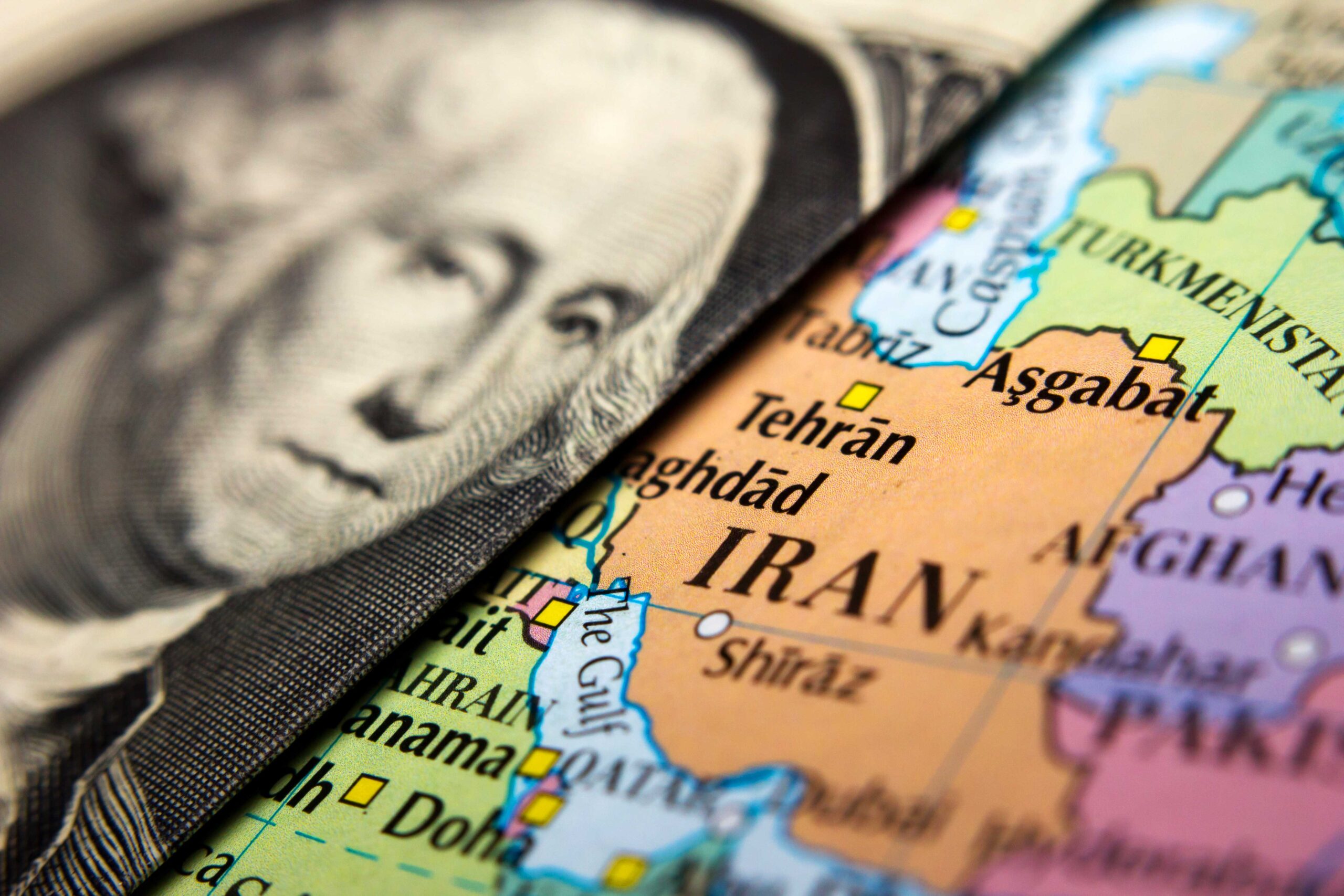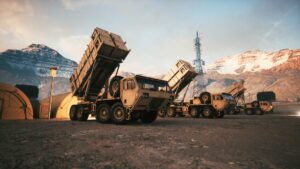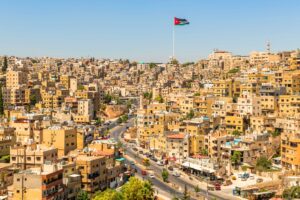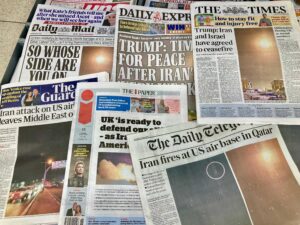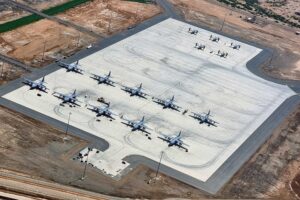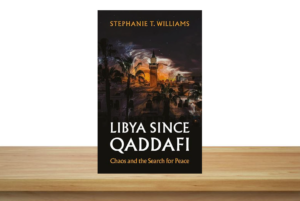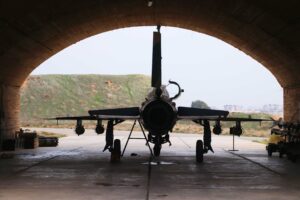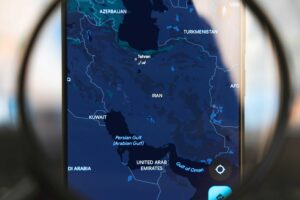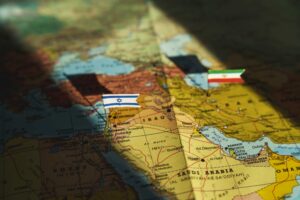Iraq’s struggle to assert its sovereignty is increasingly complicated by its entanglements with Iran and Turkey and a persistent terrorist threat. As these regional powers assert their influence, Baghdad must also manage its relationship with the United States. For the US, fostering a stable and sovereign Iraq is a key objective, while for Iraq continued American support is crucial for the country’s security, stability, and prosperity.
Regional Dynamics: Iran and Turkey’s Complicated Influence
Iran has sought to consolidate its political and military dominance through alliances with Iraqi militias and political actors, using Iraq as a strategic buffer against US and regional rivals.
Over the past two decades, even as Iraq’s internal instability has had a profoundly negative impact on the surrounding region, the country’s struggles have been compounded by the disruptive influence of two difficult neighbors — Iran and Turkey.
Despite rising tensions in Syria, the main fault line in Turkish-Iranian relations lies in Iraq[i], driven by sectarian divides and the Kurdish issue. Iran has sought to consolidate its political and military dominance through alliances with Iraqi militias and political actors, using Iraq as a strategic buffer against US and regional rivals. Turkey, meanwhile, has focused on confronting the Kurdistan Workers’ Party (PKK), which it views as a major security threat, by conducting military operations in northern Iraq.
Since 2003, Iran has become deeply embedded in Iraqi politics while supporting various Shia militias, particularly the Popular Mobilization Forces (PMF). Ankara has alternated between advocating for a non-sectarian government in Baghdad and backing the Sunnis, both strategies aimed at countering Iranian influence. In the Kurdish arena, Turkey and Iran have supported opposing Kurdish factions — Ankara aligning with the Kurdistan Democratic Party (KDP) and Tehran with the Patriotic Union of Kurdistan (PUK).
Over the past five years, Turkish forces have steadily advanced into Iraqi Kurdistan, establishing military outposts and mounting sustained offensives. Frequent clashes between Iran-backed militias and Turkish forces have occurred, often triggered by Turkish airstrikes on PKK targets, with Iranian proxies launching rocket attacks on Turkish bases under the guise of defending Iraqi sovereignty. Iran’s support for the PKK, despite its own Kurdish repression, reflects a broader strategy to counter Turkey’s growing influence in Iraq, as detailed in a declassified May 2022 report.[ii]
In vying for control in Iraq to protect their security interests and extend their influence in the Middle East, Iran and Turkey’s military operations have had a destabilizing impact on Iraq, exacerbating tensions and complicating regional security. Incursions into Iraqi Kurdistan by the Turkish Armed Forces (TAF), most recently the ground operation undertaken in July in Dohuk province[iii], have taken a severe toll on civilians[iv], resulting in the evacuation of hundreds of villages and the rendering tracts of agricultural land unusable. Similarly, since September 2018, Iran and its Iraqi proxies have carried out numerous cross-border attacks against opposition groups, notably the Kurdistan Democratic Party of Iran (KDPI[v]), the Komala Party of Iranian Kurdistan[vi], and the Kurdistan Freedom Party (PAK), particularly during the 2022 anti-government protests in Iran’s Kurdish-majority regions.[vii] Successive Iraqi governments since 2003 have struggled to restrain Turkey’s and Iran’s incursions.
The US-Iraq Relationship: Strategic Interests and Military Presence
Iraq is also a critical battleground for influence between Iran and the United States. For Iran, Iraq’s strategic importance cannot be overstated, as it serves not only as a neighbor but also as a crucial ally in advancing its broader regional objectives. Iraq will always hold greater strategic importance for Iran than for the United States. Nonetheless, achieving stability in Iraq requires foreign patronage, with the US in a prime position to offer this support, though it has largely depended on its military presence.
There are currently around 2,500 American military personnel stationed in Iraq, with an additional 900 in Syria.[viii] The official rationale for the ongoing troop deployment in Iraq is to assist in combating the remnants of the Islamic State (ISIS) and preventing its resurgence. Yet, unofficially, their presence is aimed at countering Iranian influence and disrupting Iran’s efforts to supply weapons to its proxies, including the Lebanese Hezbollah, against Israel.
Militia groups have received substantial support from Iran, including funding, weapons, and guidance from the Islamic Revolutionary Guards Corps – Quds Force.
Since October 7, Iran and its allies have leveraged the Gaza conflict to push for US troop withdrawal. Iranian-backed militias have carried out no fewer than 70 attacks on US forces in Iraq.[ix] Militia groups have received substantial support from Iran[x], including funding, weapons, and guidance from the Islamic Revolutionary Guards Corps – Quds Force (IRGC-QF), though it remains unclear if Tehran has orchestrated their attacks on US troops. The escalation in rocket and other attacks on US military personnel by Iran and its Axis of Resistance partners has been met with periodic US retaliatory strikes.[xi]
Against this backdrop, Prime Minister Mohammed Shia Al-Sudani — whose efforts to balance Iraq’s relations with both Iran and Turkey are mirrored by his government’s attempts to navigate a balanced relationship between Iran and the US — has come under mounting domestic political pressure to distance himself from the US and its Western partners. The Israel-Hamas war and the US strikes in Iraq likely made it more politically difficult for Sudani to back the continued American military presence. In response to the pressure, the Iraqi and U.S. governments established the Higher Military Commission (HMC) in January 2024[xii] to assess Iraq’s future security requirements and adjust international security support accordingly.
In April, during his week-long visit to Washington, Sudani outlined a vision for a comprehensive “360-degree strategic partnership” with the US[xiii], anchored in the 2008 Strategic Framework Agreement (SFA) which encompasses cooperation in various fields. It is noteworthy that the Coordination Framework (CF), which comprises militia groups sanctioned by the US, while endorsing the visit, nonetheless demanded a more explicit commitment to the removal of American troops.[xiv] It is also telling that on the eve of Sudani’s visit to Washington, Iran launched over 300 armed drones and missiles at Israel[xv], many of which passed through Iraqi airspace, underscoring Iraq’s security vulnerabilities.
At the conclusion of Sudani’s visit, the joint statement[xvi] emphasized the commitment of both sides to continue working together on a shared vision for a comprehensive and effective partnership to pursue common objectives. The next month, the US joined with other members of the UN Security Council in unanimously approving a request by the Iraqi government to end the mandate of the UN Assistance Mission for Iraq (UNAMI) by 2025[xvii]—an outcome Iraq framed as an affirmation of the maturity and competence of its own governing institutions.[xviii]
Nevertheless, the dynamic between Iraq and United States is complicated by the financial networks and intelligence links that exist between Iraq and Iran. American officials have raised concerns about Iraqi banks funneling dollars to Iran[xix], helping the country evade sanctions. A belated crackdown by the US Treasury has exposed how Iran-backed militias and private banks have exploited access to US dollars[xx] to fund the Islamic Revolutionary Guard Corps (IRGC) and Kataib Hezbollah (Hezbollah Brigades), among others. Meanwhile, Sudani’s government has purged many key US-trusted Iraqi National Intelligence Service (INIS) officers and replaced them with agents from Iran-backed militias, leading to what has been described as “Iran-backed state capture” of Iraq’s intelligence apparatus.[xxi]
As reported by Reuters, talks between Iraq and the US have led to a tentative agreement to withdraw American forces by the end of 2026[xxii], with plans to establish a new advisory relationship.[xxiii] The withdrawal plan reportedly includes a small residual force in Kurdistan to provide a security guarantee for Iraqi Kurds against the Iranian-backed militia groups.[xxiv] For Iran and its allies in Iraq’s government, the prospective departure of US troops is undoubtedly viewed as an opportunity to consolidate power.
President Masoud Pezeshkian’s September visit to Iraq coincided with the Sudani government’s progress on aligning with Iran’s goals[xxv], including negotiating the exit of US troops. The visit, amid rising regional tensions and fresh Western sanctions imposed on Iran[xxvi] for providing Russia with short-range missiles for use against Ukraine, underscored Tehran’s commitment to strengthening its strategic alliance with Iraq. It also underscored the tightrope the Sudani government walks in managing its complex ties with both Iran and the United States.
The Persistent Terrorist Threat
The US withdrawal of its remaining troops from Iraq is a priority for Prime Minister Sudani[xxvii], who in January was quoted as saying that the withdrawal of US troops is “crucial for Iraq’s security and stability.”[xxviii] However, just a year earlier, Sudani had expressed concern over the terrorist threat from Syria, where ISIS remains active, telling the Wall Street Journal that “we need the foreign forces.”[xxix] Sudani’s remarks invite the question: have the security threats facing Iraq truly diminished, and is the country adequately prepared to repel them?
Over the past 18 months, Iraq’s relations with both Iran and Turkey have improved, particularly regarding border security and the management of Kurdish affairs. In March 2023, Baghdad and Tehran reached agreement on border security focused primarily on disarming members of Iranian Kurdish dissident groups based in northern Iraq and preventing them from entering Iran from northern Iraq. A few months later, Iraq began relocating these groups to camps farther inland[xxx], in line with the security pact, though Tehran continued to demand that Baghdad extradite Iranian Kurdish leaders.[xxxi]
This past March, Turkish President Recep Tayyip Erdoğan made his first visit to Iraq in over a decade[xxxii], resulting in a “strategic framework agreement” centered on security, energy, water, and trade. Iraq’s National Security Council later acquiesced to Turkey’s longstanding demand to ban the PKK[xxxiii], though it stopped short of declaring the group a terrorist organization. The two countries also reached an agreement granting Turkish forces permission to carry out military operations against the PKK deep inside Iraqi territory in exchange for increased water flow from Turkey.[xxxiv]
ISIS is set to more than double its attacks from 2023.
The improvements in Iraq’s security relations with Iran and Turkey are perhaps more indicative of the country’s vulnerability than of its strength, as it navigates the interests of two neighbors vying for strategic advantage while also facing the potential resurgence of ISIS. In May, ISIS launched an attack on a military outpost between Diyala and Salahuddin provinces.[xxxv] Writing in Foreign Affairs in June, Harvard professor Graham Allison and former CIA deputy director Michael Morell sounded the alarm, noting that the “terrorism warning lights” were “blinking red again.”[xxxvi] In July, US Central Command (CENTCOM) warned that ISIS is set to more than double its attacks from 2023[xxxvii], signaling an attempt to reestablish itself after years of reduced capability. The UN estimates that the group has between 3,000 and 5,000 fighters in Syria and Iraq.[xxxviii]
The release this summer of 1,200 ISIS fighters, many of whom are Iraqi, from the Ghuwayran Central Prison in eastern Syria by the Syrian Democratic Forces (SDF) presents yet another challenge for Iraq[xxxix], despite its extensive security countermeasures. In a coordinated effort in late August, US Special Operations and Iraqi forces carried out a major raid in Anbar province[xl], targeting senior ISIS figures. The large-scale operation signaled a return to broad military efforts aimed at eliminating ISIS from the Anbar desert. Over 200 troops took part in the raid, highlighting the Islamic State’s growing presence in Iraq and raising concerns about Iraq’s ability to control ISIS.
Conclusion
Iraq’s internal political and security landscape remains fragile, as militia groups and their political allies undermine state institutions. Without international engagement, especially from the US, Iraq’s ability to control these militias and push back against extremist threats such as ISIS will be severely compromised, leaving it vulnerable to external pressures from Iran and Turkey.
The US military presence continues to play a key role in counterterrorism efforts. A precipitous withdrawal would create a vacuum that extremist forces could exploit. However, the two-year drawdown reportedly agreed appears aimed at guarding against this eventuality. Reducing the longstanding troop presence does not signal the end of US military involvement, regional withdrawal, or yielding to Iranian dominance.
A stable, independent Iraq remains a key US priority, but Washington will need to shift focus toward economic influence and diplomatic tools to achieve its goals. Iraq, in turn, must create a more secure and transparent environment to attract American businesses and investment. While sustained US support is crucial, meaningful progress will hinge not only on American patience but on mutual commitment.
[i] Azizi, H. and Cevik, S. (2022). “Turkish and Iranian Involvement in Iraq and Syria”, SWP, 12 October 2022, retrieved from: https://www.swp-berlin.org/10.18449/2022C58/.
[ii] Lead Inspector General to the United States Congress (2022). “Operation Inherent Resolve”, 31 March 2022, retrieved from: https://media.defense.gov/2022/May/03/2002988582/-1/-1/1/OIR_Q2_MAR2022_GOLD_508.PDF.
[iii] CPT (2024). “An overview of the recent Turkish military actions in Iraqi Kurdistan”, 8 July 2024, retrieved from: https://cpt.org/2024/07/08/an-overview-of-the-recent-turkish-military-actions-in-iraqi-kurdistan.
[iv] Ibid.
[v] PDKI (2024). “About – Democratic Party of Iranian Kurdistan (PDKI)”, retrieved from: https://pdki.org/english/about/.
[vi] Komala (2018). “Birth of Komala”, retrieved from: https://www.komalainternational.org/read-about.
[vii] Motamedi, M. (2022). “Iran attacks positions in northern Iraq targeting Kurdish groups”, Al Jazeera, 21 November 2022, retrieved from: https://www.aljazeera.com/news/2022/11/21/iran-attacks-positions-in-northern-iraq-targeting-kurdish-groupso.
[viii] Ibid.
[ix] Azhari, T. (2023). “US strike in Iraq kills 5 militants preparing attack”, Reuters, 3 December 2023, retrieved from: https://www.reuters.com/world/middle-east/suspected-us-strike-iraq-kills-5-militia-members-sources-2023-12-03/.
[x] The Soufan Center (2020). “IntelBrief: The United States and Iran Continue Tit-for-Tat Escalation in Iraq”, 8 January 2020, retrieved from: https://thesoufancenter.org/intelbrief-united-states-designates-asaib-ahl-al-haq-as-a-foreign-terrorist-organization/.
[xi] Reuters (2024). “What is Iran’s ‘Axis of Resistance’?”, 5 August 2024, retrieved from: https://www.reuters.com/world/middle-east/what-is-irans-axis-resistance-2024-08-05/.
[xii] U.S. Department of Defense (2024). “U.S./Iraq Higher Military Commission Principals Meeting Statement”, 9 April 2024, retrieved from: https://www.defense.gov/News/Releases/Release/Article/3735450/usiraq-higher-military-commission-principals-meeting-statement/#:~:text=The%20Higher%20Military%20Commission%20is,U.S.%20defense%20leaders%20and%20professionals.
[xiii] Abdalla, J. (2024). “Biden hosts Iraq’s Al Sudani after Iranian attack on Israel”, The National, 16 April 2024, retrieved from: https://www.thenationalnews.com/news/us/2024/04/15/biden-hosts-iraqs-al-sudani-following-iranian-attack-on-israel/.
[xiv] Al-Rahim, R. (2024). “Iraq’s Sudani Runs the Risks of Sustained Relations with the United States”, Arab Center Washington DC, 7 May 2024, retrieved from: https://arabcenterdc.org/resource/iraqs-sudani-runs-the-risks-of-sustained-relations-with-the-united-states/.
[xv] Wright, R. (2024). “Iran’s Attack and the New Escalatory Cycle in the Middle East”, USIP, 16 April 2024, retrieved from: https://www.usip.org/publications/2024/04/irans-attack-and-new-escalatory-cycle-middle-east.
[xvi] White House (2024). “Joint Statement from the Leaders of the United States and the Republic of Iraq”, 15 April 2024, retrieved from: https://www.whitehouse.gov/briefing-room/statements-releases/2024/04/15/joint-statement-from-the-leaders-of-the-united-states-and-the-republic-of-iraq/.
[xvii] UNifeed (2024). “UN/Iraq UNAMI New Mandate”, 31 May 2024, retrieved from: https://media.un.org/unifeed/en/asset/d321/d3213449.
[xviii] Iraq PMO (2024). “The end of UNAMI’s mission”, Twitter/X, 4 June 2024, retrieved from: https://x.com/IraqiPMO/status/1797978425409593442.
[xix] Cloud, D.S. (2023). “Iraqis Fly to Nearby Countries to Get Dollars as U.S. Cracks Down on Money Laundering”, The Wall Street Journal, 8 May 2023, retrieved from: https://www.wsj.com/articles/iraqis-fly-to-nearby-countries-to-get-dollars-as-u-s-cracks-down-on-money-laundering-ec366494?mod=article_inline.
[xx] Ibid.
[xxi] Knights, M. (@024). “Iraq’s Watergate and the Fallout for U.S. Relations”, WINEP, 5 September 2024, retrieved from: https://www.washingtoninstitute.org/policy-analysis/iraqs-watergate-and-fallout-us-relations.
[xxii] Azhari, T. and Rasheed, A. (2024). “US-Iraq deal would see hundreds of troops withdraw in first year, sources say”, Reuters, 6 September 2024, retrieved from: https://www.reuters.com/world/us-iraq-deal-would-see-hundreds-troops-withdraw-first-year-sources-say-2024-09-06/.
[xxiii] Azhari, T. and Rasheed, A. (2024). “Iraq eyes drawdown of US-led forces starting September, sources say”, Reuters, 22 July 2024, retrieved from: https://www.reuters.com/world/middle-east/iraq-eyes-drawdown-us-led-forces-starting-september-sources-say-2024-07-22/.
[xxiv] Salim, M., Ryan, M. and Hauslohner, A. (2024). “Iraq touts deal with U.S. to withdraw most troops by 2026, The Washington Post, 12 September 2024, retrieved from: https://www.washingtonpost.com/national-security/2024/09/12/us-troops-iraq-withdrawal/.
[xxv] Fassihi, F. and Rubin, A.J. (2024). “Iran’s New President, Tending to a Pivotal Alliance, Visits Iraq”, The New York Times, 11 September 2024, retrieved from: https://www.nytimes.com/2024/09/11/world/middleeast/iran-president-pezeshkian-iraq-visit.html.
[xxvi] DW (2024). “Ballistic missiles to Russia: US, Europe sanction Iran”, 10 September 2024, retrieved from: https://www.dw.com/en/ballistic-missiles-to-russia-us-europe-sanction-iran/a-70181326.
[xxvii] Luizard, P.J. (2024). “Iraq, the return of Daesh? The story of an instrumentalization”, CFRI, 19 April 2024, retrieved from: https://cfri-irak.com/en/article/iraq-the-return-of-daech-the-story-of-an-instrumentalisation-2024-04-19.
[xxviii] Mahmoud, S. (2024). “Iraqi PM tells Davos that US forces must leave because ISIS is no longer a threat”, The National, 18 January 2024, retrieved from: Iraqi PM tells Davos that US forces must leave because ISIS is no longer a threat | The National (thenationalnews.com).
[xxix] Cloud, D.S. and Amon, M. (2023). “Iraqi Prime Minister Supports Indefinite U.S. Troop Presence”, The Wall Street Journal, 15 January 2023, retrieved from: https://www.wsj.com/articles/iraqi-prime-minister-supports-indefinite-u-s-troop-presence-11673785302.
[xxx] Rasheed, A. (2023). “Iraq starts relocating Iranian Kurdish fighters from Iran border”, Reuters, 12 September 2023, retrieved from: https://www.reuters.com/world/middle-east/iraq-starts-relocating-iranian-kurdish-fighters-iran-border-iraq-foreign-2023-09-12/.
[xxxi] Jazaeri, I. (2024). “Iran Intensifies Pressure On Iraq To Extradite Iranian-Kurdish Leaders”, Radio Free Europe, 19 July 2024, retrieved from: https://www.rferl.org/a/iran-iraq-kurdistan-kurds-terror/33043121.html.
[xxxii] DW (2024). “Turkey’s Erdogan makes rare visit to Iraq”, 22 April 2024, retrieved from: https://www.dw.com/en/turkeys-erdogan-makes-rare-visit-to-iraq/a-68886692.
[xxxiii] Faidhi Dri, K. (2024). “15 March 2024, Rudaw, 15 March 2024, retrieved from: https://www.rudaw.net/english/middleeast/15032024.
[xxxiv] Menmy, D.T. (2024). “Water for security: Iraq-Turkey deal reveals extent of military intervention”, The New Arab, 29 April 2024, retrieved from: https://www.newarab.com/news/water-security-iraq-turkey-deal-revealed.
[xxxv] Reuters (2024). “Five Iraqi soldiers killed in ISIS attack, sources say”, 14 May 2022, retrieved from: https://www.reuters.com/world/middle-east/five-iraqi-soldiers-killed-isis-attack-army-post-eastern-iraq-two-security-2024-05-13/.
[xxxvi] Allison, G. and Morell, M.J. (2024). “The Terrorism Warning Lights Are Blinking Red Again”, Foreign Affairs, 10 June 2024, retrieved from: https://www.foreignaffairs.com/united-states/terrorism-warning-lights-are-blinking-red-again.
[xxxvii] Seldin, J. (2024). “US fears Islamic State comeback in Syria, Iraq”, VOA News, 17 July 2024, retrieved from: https://www.voanews.com/a/us-military-islamic-state-attacks-on-track-to-double-in-iraq-syria-compared-to-last-year/7701854.html.
[xxxviii] Ibid.
[xxxix] CFRI (2024). “The Return of the Threat: SDF Brandishes the ‘ISIS Detainees’ Card Once Again”, 30 August 2024, retrieved from: https://cfri-irak.com/en/article/the-return-of-the-threat-sdf-brandishes-the-isis-detainees-card-once-again-2024-08-30.[xl] Schmitt, E. (2024). “Sweeping Iraq Raid Killed 4 ISIS Leaders”, The New York Times, 13 September 2024, retrieved from: https://www.nytimes.com/2024/09/13/us/politics/iraq-raid-isis-leaders-killed.html.


